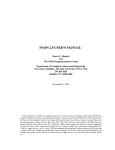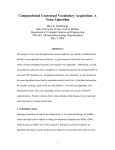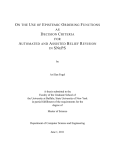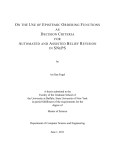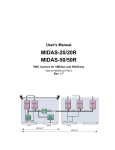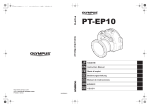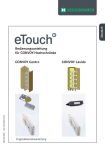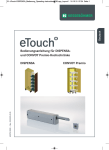Download Reinventing the Reinvented Shakey in SNePS
Transcript
Reinventing the Reinvented Shakey in SNePS
SNeRG Technical Note 36
Trupti Devdas Nayak
Michael Kandefer
Lunarso Sutanto
Department of Computer Science and Engineering
University at Buffalo, The State University of New York
Buffalo, N.Y. 14260-2000
{td23 | mwk3 | lsutanto}@cse.buffalo.edu
April 6, 2004
Abstract
This paper describes the implementation of the Shakey robot on a Magellan Pro hardware
robot. The paper gives an account of the SNePS/GLAIR architecture which has been
implemented for the Magellan Pro. It details a challenging task of reinventing Shakey in
order to expand the horizons he has inhabited so far. The aim is to utilize prior knowledge
about SNePS, build a GLAIR architecture and integrate this with the capabilities of the
Magellan Pro so that we have a robot capable of sensing, planning and acting intelligently.
The paper also describes in detail the Knowledge Level of the GLAIR architecture which is
implemented in SNePS for the Magellan Pro hardware robot.
1
2
Contents
1. Introduction
4
2. SNePS and the GLAIR Architecture
4
2.1 Knowledge Level………………………………………………………………..5
2.2 Perceptuo-Motor Level……………………………………………………… ... 5
2.2a PMLa…………………………………………………………………...5
2.2b PMLb…………………………………………………………………..5
2.2c PMLc…………………………………………………………………..5
2.3 Sensory-Actuator Level…………………………………………………………5
3. Introduction to Our Shakey
6
3.1 Magellan/Shakey’s Environment……………………………………………….6
4. Aims for Magellan
8
5. Implementing Shakey through Magellan
8
5.1 Introduction to Magellan Pro and the Mom Interface…………………………..8
5.1.1 Magellan Pro………………………………………………………….8
5.1.2 MOM Interface………………………………………………………..9
5.1.3 Getting Started………………………………………………………...9
5.1.3.1 Server on Magellan………………………………………...10
5.1.3.2 Client on Unix Machine……………………………………10
5.1.3.4 Socket Programming……………………………………….10
6. Programming Shakey in the lower levels
10
6.2.1 Accessing sensors and actuators with Mobility (SAL/PMLc)……………….10
6.2.2 MSocket: Working with Linux Sockets in C++ (PMLb and PMLc)………...11
6.2.3 Primitive actions and socket communication (PMLa/PMLb)……………….14
6.2.4 Primitive functions needed…………………………………………………..15
7. Representing the environment in SNePS
15
7.1 Source Code in SNePS………………………………………………………..15
7.2 Problems encountered…………………………………………………………23
8. Integration
24
9. Future Enhancements
9.2 Ideas for implementing a wider range of tasks
24
24
10. Summary
25
11. References/Bibliography
25
3
1. Introduction
Shanahan [5] describes in his “Reinventing Shakey” paper, an implementation of the
Shakey robot using event calculus [7] and a Khepera robot. The Shakey problem is
described as a robot placed in a closed environment containing rectangular rooms and
doors which open into adjacent rooms. In this environment there is also a package and the
robot’s goal is to calculate a path to this package from the robot’s starting location. It then
makes its way to the package using wall-following and turn-at-corner functions, and
determines its state in the world using sensors like sonar sensors. In order to do this, the
robot must have some internal representation of the world, or access to one. One problem
which exists is that a door can be shut or opened at any time, and if the robot’s original
path doesn’t work, it is up to the robot to decide which door was closed, and to calculate a
new path from its present location.
The goal of our project is to implement a Shakey robot using SNePS and iRobot’s [8]
Magellan Pro hardware robot. We are using a substantially smaller environment, two
rooms and one door connecting them, due to the size of our robot and our limited
movement space. A subsequent goal of the project is to develop this paper, detailing the
steps we took to accomplish this goal, and explaining our experiences with the systems
used, which are new to us.
2. SNePS and the GLAIR architecture
“SNePS (the Semantic Network Processing System) is a system for building, using and
retrieving information from propositional semantic networks.” [1]. SNePS is basically used
for knowledge representation at various levels. It is called ‘propositional’ because every
proposition is represented by a node in the semantic network. The arcs in the network
represent relations between the nodes they connect. We also need to construct the GLAIR
(Grounded Layered Architecture with Integrated Reasoning) for the Magellan Pro robot.
The GLAIR architecture consists of three layers [3] which is illustrated in Figure 1.
Knowledge Level
SNePS
Perceptuo-Motor Level
Sensory-Actuator Level
NL
Percepts
Action
4
Figure 1: GLAIR Architecture[4]
2.1 Knowledge Level
The KL has the knowledge base of the robot at the abstract level. It consists of what the
robot is consciously aware of. At this layer, the knowledge is represented using SNePS and
its sub-system SNeRE so that actions can be executed by the robot based on what it
believes and perceives. SNePS is implemented in Common Lisp.
2.2 Perceptuo-Motor Level
The PML has the physical level representations of the objects. It has the most primitive
actions. The PML has 3 sub-levels [3]:
2.2a PMLa
The PMLa is the highest level where the ideas that KL represents are translated into
functions. This level has the functions which will be used for implementing the KL level.
There are a set of primitive actions which determine the basic moves the robot is able to
accomplish. These functions are implemented in SNePS. These include the follow-wall and
go-straight actions performed by the robot.
2.2b PMLb
The PMLb plays a role in interfacing the PMLa and the PMLc. Its role is fuzzy in this
particular project since it is combined with PMLa and with PMLc. A mention of it is made
since the PML of the GLAIR architecture consists of 3 sub-levels.
2.2c PMLc
The PMLc level has been implemented in C++. It consists of the server program which will
execute on the robot. The C++ program has a set of functions which take input from the
program running on a client and depending on the task, the robot behaves accordingly. The
sensor functions access the hardware and receive the sonar values. Based on predetermined
threshold cut-off values, the variables front-high, front-low, left-high and left-low are set.
These variables are accessed by the higher PML layers and functions like move-front,
move-behind, turn-left and move-forward.
2.3 Sensory-Actuator Level
The SAL consists of the actual sonar sensors which determine what the robot perceives.
This input is given to the higher layers, and the plan made accordingly. The SAL can
consist of any other hardware/software devices which enable perception in the intelligent
entity with respect to the environment.
5
3. Introduction to Our Shakey
The Shakey project started in the late sixties [11], using a logic based approach. The idea
for constructing Shakey was driven by the desire to provide a high-level cognitive
implementation of a robot which is capable of mental skills attributed solely to human
beings, such as planning, reasoning about oneself, reasoning about other agents, and
communicating with other agents [5]. The Shakey project was revived and implemented for
a Khepera [5] which is a real robot, and inhabits an environment depicted in Figure 2 which
is a prototype for the environment that Magellan will inhabit which is depicted in Figure 3.
Figure 2: Shakey’s original environment [5]
The environment we will be adapting is a simpler version of the one shown in Figure 2. It
is deliberately kept simple, because this will enable us to focus on implementing it for a
much larger robot than the Khepera, and once this has been accomplished, the complexity
can be incrementally increased.
3.1 Magellan/Shakey’s environment
As of December 2003, Shakey operated in a basic environment consisting of 2 rooms
shown in Figure 3. Though the room was not large enough to have as many divisions as the
original Shakey environment, it sufficed for our needs.
6
C9
C10
Magellan
Desk
R2
Desk
C8
C7
C12
C11
C3
C4
D1
C1
C2
Actual
Entrance
to room
R1
C6
C5
Figure 3: Map of Room 329, Bell Hall
Legend:
(1) R1, R2 ----- Rooms
(2) C1, C2, C3, C4, C5, C6 ----- Corners of R1 (where C2, C3 are outer corners)
(3) C7, C8, C9, C10, C11, C12 ----- Corners of R2 (where C7, C12 are outer corners)
(4) D1 --- Door connecting R1 and R2
(5) Magellan ---- alias Shakey
The Shakey robot is assumed to move beside the left wall (follows the left wall). The arrow
in front of the robot in Figure 3 depicts the direction of movement. Our aim is to use
Shakey’s sensing capabilities and reasoning power to make it get out of R2 (room 2) into
R1 (room 1). In order to do this, Shakey has to travel from corner to corner of the room,
detecting these corners, detect a door if one is encountered, and go through the door to get
into the second room.
The following should be noted:
1. The room is small. Hence, the speed of the robot has to be maintained at a manageable
level. A threshold has to be carefully chosen so that the robot can take immediate action the
moment it detects it is now approaching a corner of the room.
7
2. The robot is self-aware. At any given point of time, Shakey should be aware of its
position in the room. If it is ‘lost’, it will remain lost because it will not ‘know’ where the
door is or which corner it is currently at.
3. As an addition to its repertoire of functions, one function proposed to be implemented
for Shakey will determine if it is moving away from the wall it is following. Shakey only
follows the left wall, so if for some reason (like, being a medium sized hardware robot, if
the wheels are not aligned well) it starts moving away from the wall, the sonar reading will
be incorrect and the robot has no idea of where it is.
4. Aims for Magellan
The main current aim for Magellan is to move along the left wall, and turning right when a
corner is encountered, and getting to room R1 through the connecting door D1.
The sub tasks Magellan should be able to achieve for the above aim are
1. Move forward, backward as the user instructs
2. Turn right when he detects a corner.
3. When a door is detected through which he has to go, as part of the plan,
he turns left at the outer corner and enters the other room.
4. He stops when the door is closed and does not keep circling the room.(this is the
sign of an intelligent robot. The robot can determine this because it has a map for
reference. When it expects a door to be present, but instead of passing a door, it
reaches a corner, it can safely assume that it passed the door, and the reason why it
did not observe the door was because it was closed. The robot’s sensors are weak,
and when the door is closed, it cannot differentiate between the wall and the door.
5. Implementing Shakey through Magellan
This gives an overview of the actual implementation process, involving design, coding and
testing.
5.1 Introduction to Magellan Pro and the MOM Interface
5.1.1 Magellan Pro
The Magellan Pro was developed by iRobot and is a recent addition (Fall 2003) to the
University at Buffalo’s Computer Science and Engineering Department. Our Magellan Pro
is equipped with several sensors: sixteen tactile sensors, used to determine if the robot has
collided with an object, sixteen sonar sensors, used to determine distances from objects,
and a camera for vision processing that can pan or tilt. As for actuators the robot is slightly
limited in that it only comes with the ability to move forward, backward, and rotate right or
left with its two wheels underneath the base. However, since the robot has an internal PC
running Linux one is capable of adding their own hardware to the unit, as long as the robot
can support the new hardware’s weight. Controlling both the sensors and actuators can be
done in two ways: either through user control or program control. Programming in the
Magellan robot is done using the mobility package, which provides various data structures
8
and functions for accessing the three services our robot provides; base actuators, base
sensors, and the camera. The mobility package is implemented using CORBA and C++,
though a great deal of CORBA knowledge isn’t needed to program the robot.
5.1.2 MOM Interface
The Magellan package also includes a software application entitled the MOM (Mobility
Object Manager) Interface. The MOM Interface allows users of Magellan to acquire data
about the various robot sensors and control the motors of the robot. For the Magellan robot
this means one can view the tactile, sonar, and camera sensors dynamically. This is both
effective for debugging, and acquiring threshold values. One can also use the MOM
information to control the Magellan’s movements and the pan/tilt functionality of the
camera. This allows one to navigate an environment getting an idea of what the robot will
need to do before jumping straight into programming. Once the MOM interface is running,
accessing these features is easy. By clicking a few drop-down menus and right clicking on
the sensor or actuator one can read or manipulate these features. Since the Mobility manual
[9] covers this nicely we’ll leave it to the reader to research how. However, there are a few
steps that must be taken first before the MOM interface can be started.
5.1.3 Getting started
There is a Unix machine which has SNePS (Lisp) installed on it. The operating system on
the robot has the software required to run it. The user logs into the robot server using the
unix machine. The robot has to be powered on in order to be able to log in. After logging
in, the server and the client programs can be compiled and loaded.
Log into the system from which the robot can be accessed. The following example
(Comments are in parenthesis) is with Michael Kandefer’s login name and directory path
using csh.
(Remote login to the robot itself using ssh.)
[mwk3@oldred ~]> ssh irobot.cse.buffalo.edu
(Source the mobility package.)
[mwk3@irobot ~]$ source ~mobility/mobility.csh
(Start the name service.)
[mwk3@irobot ~]$ name -i
(Start the sensor/actuator servers.)
[mwk3@irobot ~]$ startup
(Start MOM interface.)
[mwk3@irobot ~]$ mom
5.1.3.1 Server on Magellan
The program running on Magellan is the server program which waits for input through
sockets. The sockets connect it to the client program running on the Unix machine. The
server on Magellan is written in C++ with CORBA objects which implement the robot
motion commands. The task of the server is to parse the strings sent down the socket by the
9
Lisp/SNePS program. After parsing, the C++ program gets the primitive action which has
to be executed.
5.1.3.2 Client on Unix machine
The client is on the Unix machine because it is requesting the server for an instruction to be
executed. This is keeping in view of the fact that in the future, there will be many clients on
other machines, sending the server on the robot requests for achieving an aim. The client
program was initially written as a Lisp program. A corresponding SNePS program uses the
functions defined in the Lisp program.
5.1.3.3 Socket Programming
Sockets are the only means of communicating strings between the different processes.
Multiprocessing, Semaphores and Networking with ACL [6] is an extremely useful and
informative paper which provided information on creating a socket, sending strings across
and closing the socket. It also has information on running threads in the background which
might be needed if more than one program will be sending strings down the sockets to the
server running on the robot.
6.2 Programming Shakey in the lower levels
6.2.1 Accessing sensors and actuators with Mobility (SAL/PMLc)
One of our primary tasks for this project is to program the low level systems. To program
Shakey in the lower levels one has to know how to access the various hardware
components (PMLc/SAL) and C++/CORBA. What follows are the steps necessary and the
program used ( cserver.c++) to access the various hardware components. It is important to
note that the interface must be activated before a program will execute correctly; this is to
say the name service and sensor/actuator servers. In addition to this the appropriate
libraries must be included in the program that will manipulate the robot. This is done as
follows:
// These includes pull in interface definitions and utilities.
// This goes at the top of the PMLc C++ file
#include "mobilitycomponents_i.h"
#include "mobilitydata_i.h"
#include "mobilitygeometry_i.h"
#include "mobilityactuator_i.h"
#include "mobilityutil.h"
Once the appropriate libraries are included, all that remains before the hardware
components can be accessed is to initialize the CORBA C++ initialization and acquire
access to the robot server(s) we are interested in accessing. Once setup, we can create the
data structures for accessing the robot’s sensors and actuators. Since our robot only uses
sonar sensors and the wheel actuators we will only discuss these. This is done as follows
(some code segments below come from the Mobility manual [9]):
10
// The following code comes from the PMLc C++ file on the robot.
// This framework class simplifies setup and initialization for
// client-only programs like this one.
mbyClientHelper *pHelper;
// This is a generic pointer that can point to any CORBA object
// within Mobility.
CORBA::Object_ptr ptempObj;
// Used for accessing the robot’s actuators (wheels)
MobilityActuator::ActuatorState_var pDriveCommand;
MobilityActuator::ActuatorData OurCommand;
// Used to access the sonar sensor data
MobilityGeometry::SegmentState_var pSonarSeg;
MobilityGeometry::SegmentData_var pSegData;
// All Mobility servers and clients use CORBA and this initialization
// is required for the C++ language mapping of CORBA.
pHelper = new mbyClientHelper(argc,argv);
// Build a pathname to the component we want to use to get sensor data.
sprintf(pathName,’’%s/Sonar/Segment’’,’’Robot0’’); // Robot0 is the robot server.
// Locate the component we want.
ptempObj = pHelper->find_object(pathName);
// Request the interface we want from the object we found
try
{
pSonarSeg = MobilityGeometry::SegmentState::_narrow(ptempObj);
}
catch (...)
{
return -1; // We’re through if we can’t use sensors.
}
// Build pathname to the component we want to use to drive the robot.
sprintf(pathName,’’%s/Drive/Command’’,’’Robot0’’); // Robot0 is the robot server.
// Locate object within robot.
ptempObj = pHelper->find_object(pathName);
// We’ll send two axes of command. Axis[0] == translate, Axis[1] == rotate.
// Positive numbers mean move forward/turn left
// Negative numbers mean move backward/turn right
OurCommand.velocity.length(2);
11
// Request the interface we need from the object we found.
try
{
pDriveCommand = MobilityActuator::ActuatorState::_duplicate(
MobilityActuator::ActuatorState::_narrow(ptempObj));
}
// Catch any errors that may occur
catch (...)
{
return -1;
}
After the data structures and hardware hooks are set up, one just uses a series of function
calls to acquire data or manipulate the robot. Some examples are given below:
// Turn right for duration seconds at speed TURN_SPEED. Then stop. Remember, negative
// speeds indicate rightward movement, while positive indicate leftward movement for
// velocity[1]. The same applies for velocity[0], where positive refers to forward motion
// and negative to backwards motion. This is all done in the main thread of the program
// since current constraints do not allow one to write to the velocity data structures outside
// of the main method.
OurCommand.velocity[0] = 0.0;
OurCommand.velocity[1] = -TURN_SPEED;
pDriveCommand->new_sample(OurCommand,0);
omni_thread::sleep(duration);
OurCommand.velocity[0] = 0.0;
OurCommand.velocity[1] = 0.0;
pDriveCommand->new_sample(OurCommand,0);
// Acquire sonar data and calculate the distance from the front sonar sensor
// to the nearest object infront of it
pSegData = pSonarSeg->get_sample(0);
// Index 0 is the front sonar sensor
float tempdist = sqrt(
(pSegData->org[0].x - pSegData->end[0].x)*
(pSegData->org[0].x - pSegData->end[0].x)+
(pSegData->org[0].y - pSegData->end[0].y)*
(pSegData->org[0].y - pSegData->end[0].y));
6.2.2 MSocket: Working with Linux sockets in C++ (PMLb and PMLc)
The other part of the low level robot programming is the actual communication from the
upper level to the lower level through PMLb. In our robot this is done in a client/server
environment between the PMLb and the PMLc level using sockets. Two different
languages are being used for our socket communication (C++ and LISP). We will discuss
the server/C++ side first, which is part of PMLc. For the implementation of server side
PMLc we chose to use the MSocket class [12] and a simple parser to parse the input from
these sockets. The MSocket has a variety of functions for creating sockets,
12
sending/receiving messages over sockets, and closing the connection and are too numerous
to list, but here are the ones we used:
// The following are data structures and methods used in socket communication in C++
// To access the methods one includes msocket.h and makes the appropriate function calls
// in whatever program they are using socket communication in. In our case this is
// cserver.c++. This is not a full program, just the pertinent function calls and descriptions.
// Empty MSocket objects
MSocket S, C;
// Initialize socket on this server, on port thePort
S.Server(thePort);
// Accept client’s connection, waits until it gets a connection
S.Accept(C);
// Close server socket
S.Close();
// read from client socket into string buffer
C >> Buffer;
// write to the client socket the string in Buffer
C << Buffer;
// Close client
C.Close();
After the command is read in from the socket it is parsed to see which action should be
executed by the robot. This is done as follows:
char *command; // command to execute
int duration; // duration to run the command
// Parse the command
command = strtok(Buffer, " ");
// Check what the command is, and parse it if necessary.
// Then execute the appropriate action
if(strcmp(command, "quit")==0)
{
cout << ‘‘Quit the program.’’ << endl;
break;
}
else if(strcmp(command, "forward")==0)
{
// Run code necessary for parsing time data, and then move the robot forward
}
// Similar code is used for moving backwards, turning right, and turning left
13
6.2.3 Primitive actions and socket communication (PMLa/PMLb)
For our SNePS network to work it needs to have the capability to communicate with the
primitive functions implemented in the PMLc, this is done first by writing the primitive
functions in the PMLa and using the PMLb to communicate these actions to the robot using
socket connections. Socket connections in C++ have already been described, and Santore
[6] already has a paper on how to do multiprocessing and socket connection in LISP, so we
will just show a few of the PMLa/PMLb primitive functions we are using.
;; Client that interfaces with the robot.
(defvar *interface-socket* nil "The socket that connects to the robot.")
(defvar *isFrontHi* nil "If the front sensors are hi (t) or low (nil).")
(defvar *isLeftHi* nil "If the left sensors are hi (t) or low (nil).")
(if (not (find-package :mp))
(require :process))
(defun ProcessSensorInput ()
“Listen for any messages from the server in a separate process, and take action”
(let ((InString "")
(socket-output-lock (mp:make-process-lock)))
;;while we don’t read a hangup, loop and play with the input
(loop do
;;get the next input sentence - trim off nulls
;;from the beginning and the end (reading to the eol
;;will leave behind a null)
(mp:wait-for-input-available *interface-socket*)
(setf InString (string-trim ’(#\null)
(read-line *interface-socket*)))
;; Determine the command sent, and set the appropriate variable
(cond
((string= InString "front low") (setf *isFrontHi* nil))
((string= InString "front hi") (setf *isFrontHi* t))
((string= InString "left low") (setf *isLeftHi* nil))
((string= InString "left hi") (setf *isLeftHi* t)))
until (equalp InString "Quit")))
(close *interface-socket*))
(defun OpenConnection ()
“Open up a connection to the robot server”
(let ((port ’()) (machine "irobot.cse.Buffalo.EDU"))
(pprint "What port is the server being run on?> ")
(setf port (read))
;;now actually make the socket, connecting at the same time
(setf *interface-socket* (socket:make-socket :remote-host machine
:remote-port port)))
(mp:process-run-function "Input Thread" #’ProcessSensorInput))
14
(defun move-forward (theTime)
“Moves the robot forward for a specified time. There are similar functions for move
backward, turn right, and turn left.”
(cond
((not (null *interface-socket*))
(write-line (format *interface-socket* "forward ~A" theTime))
(force-output *interface-socket*))))
6.2.4 Primitive functions needed
Magellan has a set of moves which can be described as primitive. They are the following
which are implemented in Lisp. The primactions are called from the SNePS code.
Making the robot move
(1)Move forward: Magellan moves ahead in a straight line. It follows the left wall.
(2)Move backward: Magellan moves backwards in a straight line. In order to ensure that it
does not bump into an obstacle/wall behind it, the sonar readings from behind the robot, or
the bump readings have to be observed and accordingly planning has to be implemented.
(3)Turn left: Magellan makes a left turn from its original position. He rotates by 90 degrees
to face the left direction from his original position. The sonar readings from the left of the
robot have to be observed. This primitive allows the robot to go straight through a doorway
and from one room to another. When the robots left sensors go low, it has encountered an
open door, hence it needs to take a left turn to get into the doorway (it takes a left turn at an
outer corner). Then, the robot goes straight through the doorway and turns left again. The
robot is now in the adjacent room, beside the left wall.
(4)Turn right: Magellan turns 90 degrees to the right. When the robot encounters an inner
corner, the sonar readings from the front of the robot and the left of the robot are both high.
Hence, he has to take a right turn at the corner and continue following the left wall.
(5)Stop: Magellan stops.
If the only door in room R1 is closed, the robot should not keep circling the room. It should
stop after some time. This is because being a hardware robot, there has to be a definite
stopping condition which will eventually be satisfied if the goal(s) / sub goal(s) of the plan
are not being reached. One way in which this can be achieved is by letting the robot be self
aware. When the robot passes a closed door, it should know when at the next corner, that it
missed a door because the door was closed. The logic can be programmed such that when
the door is closed, and the Magellan Pro robot moves past the closed door, the robot just
stops. Because until the room door opens, the robot will not get to its final goal plan.
7. Representing the environment in SNePS
7.1 Source Code in SNePS
With reference to the simple room which is being inhabited by Magellan, the following
objects and relations are to be considered. This is code from the Combined_KL.SNePS
which has the KL level SNePS code that we wrote.
15
;;; ================================================
;;; KL for Shakey Reimplementation
;;; Lunarso Sutanto & Trupti Devdas Nayak
;;; (December 2, 2003) (November 21, 2003)
;;; Based on M. Shanahan's "Reimplementing Shakey"
;;; ================================================
(resetnet t)
;;;----------------------------;;; define objects and relations
;;;-----------------------------
(define agent act action
class member
object1 object2 object3
lex arg1 rel arg2
proper-name property
room wall door corner
the-door room
connected-by-door
next-corner
inner-corner
outer-corner
corner-before corner-after
sensor current
)
;;; ---------------------------;;; Load required files
;;; ---------------------------;^^
; Load 'Lisp files'
;;; :ld <path of the lisp files>
(load “/home/csgrad/td23/irobot/pmla.lisp”)
;^^
;;; describe the environment consisting of a door, 12 corners, 2 rooms and 8 walls
;;; -------------------------------------------------------------------------(describe (assert member (r1 r2) class room))
(describe (assert member (c1 c2 c3 c4 c5 c6 c7 c8 c9 c10 c11 c12) class corner))
(describe (assert member d1 class door))
;;; Assert relations between room parts
16
;;; -----------------------------------(describe (assert room r1 room r2 connected-by-door d1))
(describe (assert object1 c2 property outer-corner))
(describe (assert object1 c3 property outer-corner))
(describe (assert object1 c7 property outer-corner))
(describe (assert object1 c12 property outer-corner))
;;; I am including it here, so that the
;;; relationship between the corners can be observed. Rather than a corner being a
;;; property of the room, it is easier to think of corners as ‘before’ and ‘after’ other
;;; corners. This gives a clock-wise ordering of the corners in the room.
;;; Description of corner ordering
;;; ------------------------------------(define between-corner1 between-corner2)
(describe (assert room r1 corner-before c1 corner-after c2))
(describe (assert room r1 corner-before c2 corner-after c3))
(describe (assert room r1 corner-before c3 corner-after c4))
(describe (assert room r1 corner-before c4 corner-after c5))
(describe (assert room r1 corner-before c5 corner-after c6))
(describe (assert room r1 corner-before c6 corner-after c1))
(describe (assert room r2 corner-before c7 corner-after c8))
(describe (assert room r2 corner-before c8 corner-after c9))
(describe (assert room r2 corner-before c9 corner-after c10))
(describe (assert room r2 corner-before c10 corner-after c11))
(describe (assert room r2 corner-before c11 corner-after c12))
(describe (assert room r2 corner-before c12 corner-after c7))
(describe (assert the-door d1 between-corner1 c2 between-corner2 c3))
(describe (assert the-door d1 between-corner1 c7 between-corner2 c12))
(describe
(add forall ($c1-var $c2-var $door-var)
ant (build the-door *door-var
between-corner1 *c1-var
between-corner2 *c2-var)
cq (build the-door *door-var
between-corner1 *c2-var
between-corner2 *c1-var)))
17
;;; These primactions call the Lisp functions which actually make the robot move. It
;;; is necessary to load the Lisp files before these functions are called. These
;;; primactions print out the corresponding message as the robot performs the action.
^^
(define-primaction move-forward ()
" Moving forward."
(format t "~&*** Moving forward now. ~%"))
(define-primaction move-backward ()
"Moving backward."
(format t "~&*** Moving backward now. ~%"))
(define-primaction turn-left ()
"Turning right."
(format t "~&*** Turning left. ~%"))
(define-primaction turn-right ()
"Turning right."
(format t "~&*** Turning right. ~%"))
(attach-primaction
move-forward move-forward move-backward move-backward turn-left turn-left
turn-right turn-right believe believe disbelieve disbelieve
sniterate sniterate
snsequence snsequence)
;;; sense-left-prim and sense-right-prim are functions which use the sensor values
;;; returned by the lisp functions sense-left-lisp. Based on the values returned, the
;;; next step is taken.
;;; Note that a high sensor value means that the associated sensor is CLOSE
;;; to a wall and when the sensor value is low, it means that it is AWAY from a
;;; wall.
;;; ------;;; You figure out that doing the moving actions are complete when the
;;; associated sensors fires.
;;; Note that a high sensor value means that the associated sensor is CLOSE
;;; to a wall
^^
(define-primaction sense-front-prim ()
;; Let variable s be the sensor data, 0 for lo, 1 for hi
(if (null (sense-front-lisp))
(believe-low 'front)
18
(believe-high 'front)
)
(define-primaction sense-left-prim ()
;; Let variable s be the sensor data, 0 for low, 1 for high
(if (null (sense-left-lisp))
(believe-low 'left)
(believe-high 'left))
;;; ---------------;;; Helper functions
;;; ---------------(defun believe-high (direction)
#!((perform (build action believe
object1 (build sensor ~direction current high)))))
(defun believe-low (direction)
#!((perform (build action snsequence
object1 (build action disbelieve
object1 (build sensor ~direction
current high))
object2 (build action believe
object1 (build min 0 max 0
arg (build sensor ~direction
current high)))))))
;;; debug
(defun sense-front-lisp () 5)
(attach-primaction sense-front-prim sense-front-prim
sense-left-prim sense-left-prim)
^^
;;; =======================================
;;; COMPLEX ACTS
;;; follow-wall
;;; ----------;;; Follow wall is ’self-aware’, which means that in this KL level, it
;;; will know whether it’s already close to a corner.
;;;
;;; Currently, this version of follow-wall will only work correctly when
;;; it’s following a wall towards an inner corner. We will have to add an
;;; ’or’ clause to the sensor checking (remember that when moving towards an
;;; inner corner, the front sensor is expected to go high; but when moving
;;; towards an outer corner, the left sensor is expected to go from low to
;;; high).
;;;
;;; Following a wall has these Preconditions:
19
;;; 1. variables *corner and *room are of the proper classes
;;; 2. the next-corner is defined
;;; 3. the wall that the robot is next to is defined
;;; 4. *not yet* Cassie expects the next-corner to be an inner or outer
;;; corner
;;;
;;; The Plan is to keep on moving forward until (FrontSensor <-> Left Sensor).
;;; If FrontSensor/LeftSensor is high, then Cassie knows it is at an inner
;;; corner. If FrontSensor/LeftSensor is low, then Cassie knows it is at
;;; an outer corner. Right now, we’re simplifying this to only checking the
;;; front sensor.
;;;
;;; While the associated sensor is not believed to be High,
;;; perform primitive action move-forward
;;; and update associated sensor status
;;; Once completed, disbelieve that robot is beside-wall
;;; and believe that robot is at-corner *next-corner
;;;
;;; The associated sensor = front sensor if *next-corner is an inner corner
;;; and associated sensor = left sensor if *next-corner is an outer corner
(describe
(assert forall ($c1 $c2 $room)
&ant ((build member *c1 class corner)
(build member *c2 class corner)
(build member *room class room)
(build room *room corner-before *c1 corner-after *c2)
(build beside-wall (build corner1 *c1 corner2 *c2))) ;redundant?
cq (build act (build action follow-wall)
plan(build action sniterate
object1 ((build condition
(build min 0 max 0
arg (build sensor front current high))
then
(build action snsequence
object1 (build action move-forward-prim)
object2 (build action sense-front-prim)))
(build else
(build action snsequence
object1 (build action disbelieve
object1 (build beside-wall
(build corner1 *c1 corner2 *c2)))
object2 (build action believe
object1 (build at-corner *c2)))))))))
;;; turn-right
;;; ---------;;; This act will make the robot turn 90 degrees. Because of current
;;; time constraints, We have not made the turning "self-aware" as we did
;;; for follow-wall. Thus this turn-right function assumes that the robot
20
;;; always turn right correctly.
;;;
;;;
;;; Preconditions:
;;; 1. variables *corner and *room are of the proper classes
;;; 2. Cassie knows it’s currently at an outer corner
;;; 3. Cassie knows that the corner it’s at and the next corner define
;;; the door that it want to turn towards.
(describe
(assert forall ($c1 $c2 $door $room)
&ant ((build member *c1 class corner)
(build member *c2 class corner)
(build member *door class door)
(build member *room class room)
(build at-corner *corner1)
(build room *room corner-before *c1 corner-after *c2)
(build the-door *door between-corner1 *c1 between-corner2 *c2)
cq ((build act (build action sturn-right)
plan(build action turn-right-prim))
(build action disbelieve
object1 (build at-corner *c1))
(build action believe
object1 (build in-doorway *door room *room1))))))
;;; turn-left - when in doorway
;;; ---------;;; Similar to turn-right, this function is currently *not* self-aware;
;;; it assumes that the PML levels make the robot turn 90 degrees to the
;;; right and completes the action correctly.
;;;
;;; This is an snsequence of these actions in order:
;;; 1. turn left 90 degrees
;;; 2. move-forward 4 times
;;; 3. turn left 90 degrees
(describe
(assert forall ($c1 $c2 $c3 $door $room1 $room2)
&ant ((build member *c1 class corner)
(build member *c2 class corner)
(build member *c3 class corner)
(build member *door class door)
(build member *room1 class room)
(build member *room2 class room)
(build in-doorway *door room *room1)
(build the-door *door between-corner1 *c1 between-corner2 *c2)
(build room *room1 room *room2 connected-by-door *door)
(build room *room2 corner-before *c2 corner-after *c3))
21
cq ((build act (build action sturn-left)
plan(build action snsequence
object1 (build action turn-left-prim)
object2 (build action move-forward-prim)
object3 (build action move-forward-prim)
object4 (build action move-forward-prim)
object5 (build action move-forward-prim)
object6 (build action turn-left-prim)))
(build action disbelieve
object1 (build in-doorway *door room *room1))
(build action believe
object1 (build beside-wall
(build corner1 c2 corner2 c3))))))
The comments are self-explanatory, though we hope to include diagrams of their logic in a
revised paper. The format of these complex actions is basically a bunch of antecedents
describing the preconditions of performing that act, and then what happens when the act is
performed. The act is described as a plan consisting of a sequence of primitive actions and
then updates of the fluents. Do take a close look at Follow-Wall and note how the act is
performed as a loop of sensor-detection and forward movement. This is actually quite an
awful way of performing the action and is discussed further in the next section. Note also
that there are two turn-lefts: one is for turning into a doorway and the other is for turning
out of a doorway. This “polymorphism”, so to speak, is possible since the preconditions to
the actions are dfferent.
Robot Planning
The robot’s planning is actually a simple snsequence of follow-wall and turn actions,
depending on where the robot starts. For example, given that the robot starts at the wall in
between corners c1 and c2, its plan will be to follow-wall, turn-left, follow-wall, turn-left,
follow-wall, turn-left twice and be at the goal room. This simplistic goal-plan is sufficient
for this stage.
;;; The robot needs to be in an initial start state prior to taking input through the
;;; sensor and changing the beliefs.
;;; Initially, front sensor not high, so it believes it is not in front of a wall
(perform (build action believe
object1 (build min 0 max 0
arg (build sensor front current high))))
;;; Initially, left sensor is high, so it believes it is beside a wall
(perform (build action believe
object1 (build sensor left current high)))
(perform (build action believe
object1 (build beside-wall
(build corner1 c9 corner2 c10))))
22
7.2 Problems Encountered
A few problems were encountered during the implementation phase:
1. The original Shakey design does not take into account the fact that the robot might
go off course if it moves away from the wall it is following. This is a likely event in
the case where the robot wheels are not perfectly aligned and there is a chance of
the path the robot is following will be skewed. In this case, the solution would be to
have a cut-off for the sensor input from the left sensors, which would indicate if the
robot was moving too far away from the wall. If the sensor input went low, below
this threshold, it will indicate that the robot is not very near the wall.
2. Another major problem that came up was one which has been encountered on
previous occasions during the implementation of other cognitive entities. The fact
that in software, instructions are executed in very less time, whereas in hardware, in
the read world, it takes a non-negligible amount of time to actually execute the
command issued.
The commands which were issued by the client program (the process on the
Unix machine) were sent through the socket to the server process running on the
robot. For example, the move-forward command. The server process on the robot is
supposed to issue to command to make the hardware robot move-forward and the
sensor input will be recorded after the move has been completed, and based on the
new sensor input, the client on the Unix side can issue the next command. The
problem being faced was that the client process was in a loop where it would send a
move-forward command, and check for changes in sensor input and issue a moveforward command again. The looping was too fast for the real world
implementation to complete executing the move-forward commands. Too many
move-forward commands were queuing up on the server side (robot) because of
which the actions performed were not what was expected.
A few solutions were suggested. One of which was to take care of the
changes in sensor input on the server side itself. (robot side). Hence, when a moveforward command is issued, the robot moves forward until a change in sensor input,
which will indicate it’s at a corner or beside an open door. Then the client SNePS
program can follow appropriate logic and issue the next command. We are working
on implementing this.
3. Mobility data structures can only be accessed from the main thread it seems.
4. The robot is currently tethered to the wall by an ethernet cable, which limits the
mobility of the robot.
5. Learn X11 libraries in C++ to work with the camera.
23
8 Integration
The final step of the project is the integration of all the modules each participant of the
seminar has produced. One is the PML level code. Another is the KL SNePS representation
of environment and rules. These should be integrated for the robot to use its knowledge
base (KL) to determine a goal and subsequently build a plan to reach that goal. During the
course of executing that plan, it also uses the Lisp functions which are linked to
primactions through SNePS. The robot is goal-oriented and keeps planning and replanning
till it reaches its goal, or its goal is deemed unreachable, at which point it stops.
During integration of the various modules, there was not much difficulty. The SNePS
functions call the Lisp functions and the variables for sensor input are accessible to SNePS.
9. Future enhancements
There is immense scope for future implementations being more ambitious because of the
wide range of capabilities possessed by Magellan. Some of the future aims are
1. The initial aim was the more ambitious implementation of a delivery agent. Given a
packet and a destination where the packet has to be delivered, Magellan uses prior
knowledge, and mapping techniques to chart out a path from his current position to
the destination. The proposed use for the onboard camera was identification of
people based on the color of their clothes. Every person will be identified by a blob
of color on top (shirt) and a blob of color on the bottom (jeans).
Magellan will reach the person to whom the packet has to be delivered, using the
mapping techniques and knowledge of the floor(s), (he might even use the elevator)
.The mapping techniques are to be chosen from either topological mapping or grid
based mapping or a combinational algorithm which makes use of both concepts.
2. Learn X11 libraries in C++ to work with the camera.
3. Develop follow wall primitive instead of just having move-forward, move-backward,
move-left and move-right.
9.2 Ideas for implementing a wider range of tasks
Because the hardware robot provides an excellent way of hands on programming, it is
important to list the different hardware features which can be used to enhance the
capabilities of the robot.
8.2.1 Camera
Identify people through blobs of color
8.2.2. Mapping
Robust Topological mapping (explore and learn)
8.2.3. Speech driven robot.
A sound card has to be fitted onto the robot, so that it can respond to natural language
commands along with command strings through the Unix client.
24
10. Summary
There are still many obstacles to overcome with these new systems we are working with,
despite the many that have been overcome already. This has been an extremely good
learning experience. We hope to successfully implement all the proposed ideas. Magellan
is the reinvented Shakey.
11. References/Bibliography
[1] Stuart C. Shapiro and The SNePS Implementation Group. SNePS 2.6 User's Manual
Department of Computer Science and Engineering, University at Buffalo, The State
Universtiy of New York, Buffalo, NY, October 7, 2002
[2] Scott Napieralski. Dictionary of CVA SNePS Case Frames
http://www.cse.buffalo.edu/~stn2/cva/case-frames/
[3] Stuart C. Shapiro and Haythem O. Ismail. Anchoring in a Grounded Layered
Architecture with Integrated Reasoning. Robotics and Autonomous systems 43 (2003) 97108.
[4] Stuart C. Shapiro, The SNePS Approach to Cognitive Robotics, presented to LIMSICNRS, Universite de Paris Sud, Orsay, France, December 19, 2002. (A powerpoint
presentation)
[5] M.P.Shanahan. Reinventing Shakey, in Logic-Based Artificial Intelligence.
ed. Jack Minker, Kluwer Academic. 2000
pages 233-253.
[6] John F. Santore. Multiprocessing, Semaphores and Networking with ACL, SNeRG
Technical Note 33, Department of Computer Science and Engineering, University at
Buffalo, The State Universtiy of New York, Buffalo, NY, September 5, 2002
[7] M.P.Shanahan, The Event Calculus Explained, in Artificial Intelligence Today, ed.
M.J.Wooldridge and M.Veloso, Springer Lecture Notes in Artificial Intelligence no. 1600,
Springer (1999), pages 409-430.
[8] IRobot.
http://www.irobot.com/
[9] IRobot’s Mobility Manual
http://www.cse.buffalo.edu/shapiro/Courses/CSE716/MobilityManRev4.pdf
[11] N.J.Nilsson, ed. Shakey the Robot, SRI Technical Note no. 323 (1984), Menlo Park,
California
[12] MSocket Class.
http://www.code.ghter.com/linux2.html
25




























